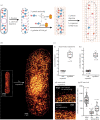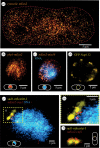Combining single-molecule and expansion microscopy in fission yeast to visualize protein structures at the nanostructural level
- PMID: 38320620
- PMCID: PMC10846934
- DOI: 10.1098/rsob.230414
Combining single-molecule and expansion microscopy in fission yeast to visualize protein structures at the nanostructural level
Abstract
In this work, we have developed an expansion microscopy (ExM) protocol that combines ExM with photoactivated localization microscopy (ExPALM) for yeast cell imaging, and report a robust protocol for single-molecule and expansion microscopy of fission yeast, abbreviated as SExY. Our optimized SExY protocol retains about 50% of the fluorescent protein signal, doubling the amount obtained compared to the original protein retention ExM (proExM) protocol. It allows for a fivefold, highly isotropic expansion of fission yeast cells, which we carefully controlled while optimizing protein yield. We demonstrate the SExY method on several exemplary molecular targets and explicitly introduce low-abundant protein targets (e.g. nuclear proteins such as cbp1 and mis16, and the centromere-specific histone protein cnp1). The SExY protocol optimizations increasing protein yield could be beneficial for many studies, when targeting low abundance proteins, or for studies that rely on genetic labelling for various reasons (e.g. for proteins that cannot be easily targeted by extrinsic staining or in case artefacts introduced by unspecific staining interfere with data quality).
Keywords: Schizosaccharomyces pombe; correlative expansion microscopy; expansion microscopy; photoactivated localization microscopy; protein retention yield; single-molecule localization microscopy.
Conflict of interest statement
Authors declare no competing interests.
Figures



Similar articles
-
Quantitative single-molecule microscopy reveals that CENP-A(Cnp1) deposition occurs during G2 in fission yeast.Open Biol. 2012 Jul;2(7):120078. doi: 10.1098/rsob.120078. Open Biol. 2012. PMID: 22870388 Free PMC article.
-
Kinetochore Components Required for Centromeric Chromatin Assembly Are Impacted by Msc1 in Schizosaccharomyces pombe.Genetics. 2017 Oct;207(2):559-569. doi: 10.1534/genetics.117.300183. Epub 2017 Aug 21. Genetics. 2017. PMID: 28827290 Free PMC article.
-
Mis16 and Mis18 are required for CENP-A loading and histone deacetylation at centromeres.Cell. 2004 Sep 17;118(6):715-29. doi: 10.1016/j.cell.2004.09.002. Cell. 2004. PMID: 15369671
-
Does a GATA factor make the bed for centromeric nucleosomes?Cell Cycle. 2003 Jul-Aug;2(4):277-8. Cell Cycle. 2003. PMID: 12851470 Review.
-
Two distinct pathways responsible for the loading of CENP-A to centromeres in the fission yeast cell cycle.Philos Trans R Soc Lond B Biol Sci. 2005 Mar 29;360(1455):595-606; discussion 606-7. doi: 10.1098/rstb.2004.1614. Philos Trans R Soc Lond B Biol Sci. 2005. PMID: 15897182 Free PMC article. Review.
Cited by
-
DNA-PAINT Imaging with Hydrogel Imprinting and Clearing.ACS Sens. 2025 May 23;10(5):3340-3346. doi: 10.1021/acssensors.5c00616. Epub 2025 May 9. ACS Sens. 2025. PMID: 40344408 Free PMC article.
References
-
- Abbe E. 1873. Beiträge zur Theorie des Mikroskops und der mikroskopischen Wahrnehmung. Archiv f. mikrosk. Anatomie 9, 413-468. (10.1007/BF02956173) - DOI
MeSH terms
Substances
LinkOut - more resources
Full Text Sources
Miscellaneous

